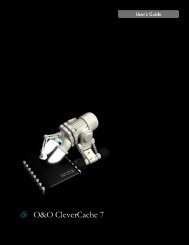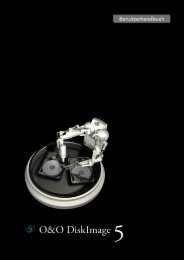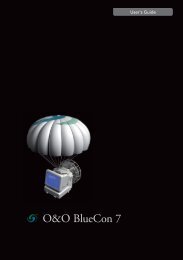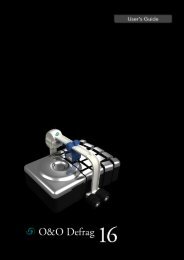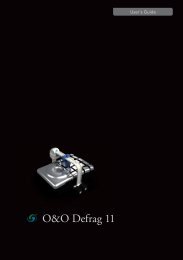O&O DiskImage 7 User's Guide - O&O Software
O&O DiskImage 7 User's Guide - O&O Software
O&O DiskImage 7 User's Guide - O&O Software
Create successful ePaper yourself
Turn your PDF publications into a flip-book with our unique Google optimized e-Paper software.
Scheduling functions<br />
Scheduling functions<br />
The Job Assistant provides options for scheduling program functions to be run automatically. You can, for example,<br />
plan to have your data drives imaged once a week.<br />
• You will be forwarded to the corresponding activity window for your selected job via Jobs and reports, which<br />
lists all jobs and reports created in O&O <strong>DiskImage</strong>. With a double click you can see the corresponding report or<br />
edit the job.<br />
• You can create a new job schedule by clicking the Add as job symbol after selecting the drive or a folder in the<br />
activity window.<br />
Note: In order to execute jobs on a regular basis, the starting conditions (e.g., source drive, images, or target drives)<br />
have to be the same. If you make changes to a drive's name, the storage location of the image, or on the layout of a<br />
target drive, the job may no longer be executed successfully.<br />
Example: If you've created a job for incremental imaging, you need to enter where you saved all the previous<br />
images serving as a basis for the new incremental image. If you've moved the "base image" to another storage location,<br />
you'll need to enter the new storage location in the Job Assistant: otherwise the new path will not be found and<br />
the job cannot be run successfully.<br />
Note: The tabs for Scheduling and Notification are not available in the Job Assistant when starting from the O&O<br />
DIskImage bootable medium.<br />
Create a Job – General information<br />
Before setting up a job, you’ll have to select an activity.<br />
1. On the start page, click the activity you want to perform, e.g. Drive imaging, or File backup.<br />
2. Select a drive or, in case of a file backup, a folder.<br />
3. Click Options if you want to specify certain settings for a job, such as the imaging method, encryption, or compression.<br />
Your settings will then be saved and applied to the subsequent job.<br />
4. Now click the symbol Add as job.<br />
5. Enter the name of your job in the dialog. It will later be used for the creation of the report and serve as reference.<br />
The name of the job has only symbolic meaning and may already be applied to other jobs.<br />
6. Specify further settings such as scheduling, notification, imaging, etc.<br />
In the field Notes you may enter text for providing a few details about the job.<br />
Job enabled<br />
If you don't wish to run a job for a short period of time but don’t want to delete it altogether, you may disable it. The job<br />
will then not be run until you enable it once again.<br />
O&O <strong>DiskImage</strong>-53



